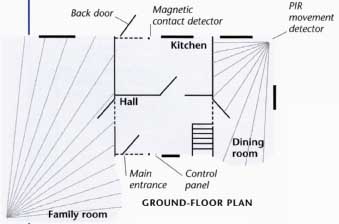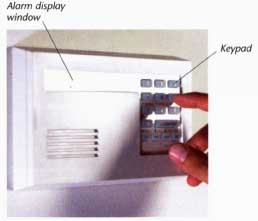Introduction
Intruders fear detection, making light and sound excellent deterrents to unwelcome visitors. With an increase in the availability and reliability of battery-operated alarm systems, installing them yourself is now easy and quick. This section deals with issues of security in the home as well as issues of safety.
Installing an Alarm System
The vast majority of alarm systems use sensors to detect movement or magnetic contact plates that set off the alarm when parted. The most commonly used sensors are called passive infrared detectors (PIRs), which detect the movement of a heat source. The most important thing to consider when installing alarms is the positioning of these sensors, so that they can monitor all the necessary zones in your home.
PIR Positioning Tips
- Know the detection range of your PIR.
- Detection of movement across the detection arc is better than of movement toward or away from the sensor.
- Do not position PIRs in direct sunlight or near a heat source, unless instructed to do so, or if solar power is required for operation.
- Avoid areas of excessive vibration or where there are drafts.
- If you live in an apartment, you may only need to consider detection around the front door area, although you may need to consider window access in ground- and first-floor dwellings.
Security House Plan
A sensor is placed at each access point to your house, which divides the area into zones. This lets you see at a glance where a zone has been breached, or where some maintenance is required. Front, back, and patio doors, windows, and fire escapes should be considered, although you may decide that some windows are inaccessible.
Remember that pets will have to be kept out of zones when the alarm is on unless you buy a system that can detect them by being sensitive to size. When you purchase an alarm it's worth checking for any extra features such as a panic button, or anti-tamper safeguards for sensors and the control panel.

Diagram shows: GROUND-FLOOR PLAN
Typical zone layouts: Along with PIRs (passive infrared detectors) and magnetic contact plates, other less common devices are pressure pads, and vibration detectors for doors and windows. PIR movement detector; back door; magnetic contact detector.

Image shows: Arming and disarming alarm systems. Take time
to study your instruction manual so that you fully understand how to
arm and disarm the system. Large systems may allow you to alarm just
some zones of the house as well as the whole house.